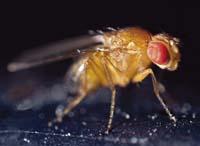Flies release hydrogen and deuterium differently

Researchers at the Greek research center Alexander Fleming have shown that Drosophila melanogaster flies separate hydrogen and deuterium through smell. According to them, this result reinforces the theory of smell through vibrations, but this theory is not the most accepted and the debate has awakened.
The most accepted theory to explain the mechanism of smell is that for each smell there is a specific receptor in the nose. The problem with this hypothesis is that there are many smells and it is difficult for the body to have so many types of receptors. Another theory is that the nose detects the vibrations of the molecules and detects many odors by combining a few modes of vibration. However, it is very difficult to demonstrate this theory.
In Greek research they have used hydrogen and deuterium to try to prove this hypothesis. Being two isotopes of the same atom, although the hydrogen of any substance is replaced by deuterium, it is the same substance. However, the modes of vibration of this substance change. If the first theory were correct, the substitution of hydrogen by deuterium would not alter the smell of the substance, and if the second theory were correct, yes.
Flies have detected a different smell in both cases of acetofenonari, a substance of their taste, that is, it has been the result of the theory of vibrations. However, the debate is not over, as some scientists do not believe that change is a real consequence of vibration.
Buletina
Bidali zure helbide elektronikoa eta jaso asteroko buletina zure sarrera-ontzian











